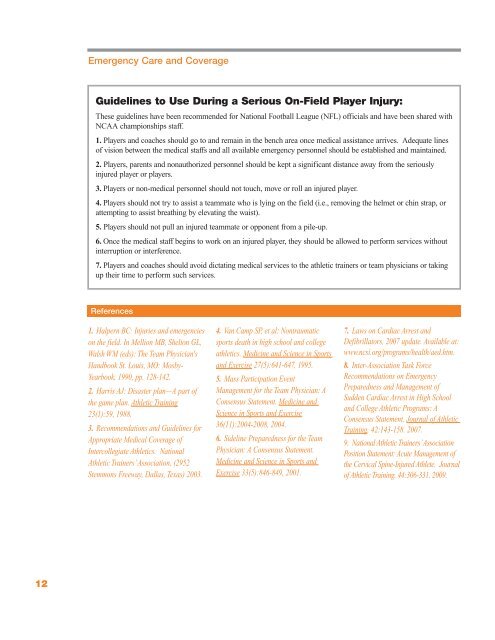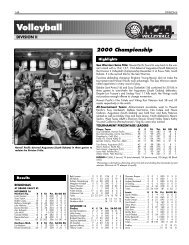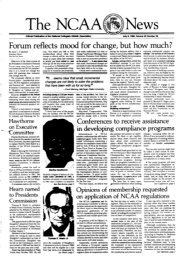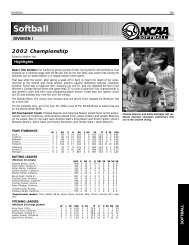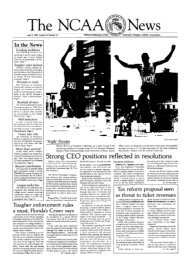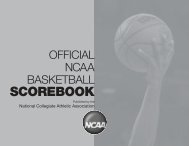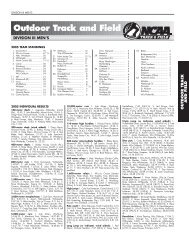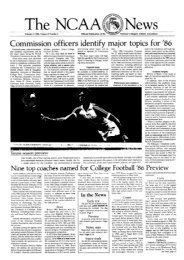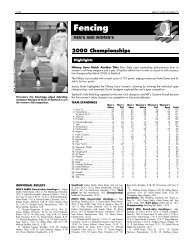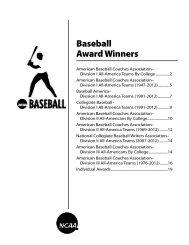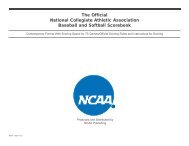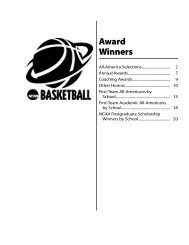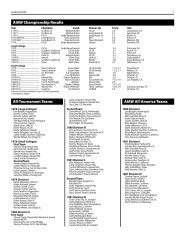Sports Medicine Handbook - NCAA
Sports Medicine Handbook - NCAA
Sports Medicine Handbook - NCAA
You also want an ePaper? Increase the reach of your titles
YUMPU automatically turns print PDFs into web optimized ePapers that Google loves.
12<br />
Emergency Care and Coverage<br />
Guidelines to Use During a Serious On-Field Player Injury:<br />
These guidelines have been recommended for National Football League (NFL) officials and have been shared with<br />
<strong>NCAA</strong> championships staff.<br />
1. Players and coaches should go to and remain in the bench area once medical assistance arrives. Adequate lines<br />
of vision between the medical staffs and all available emergency personnel should be established and maintained.<br />
2. Players, parents and nonauthorized personnel should be kept a significant distance away from the seriously<br />
injured player or players.<br />
3. Players or non-medical personnel should not touch, move or roll an injured player.<br />
4. Players should not try to assist a teammate who is lying on the field (i.e., removing the helmet or chin strap, or<br />
attempting to assist breathing by elevating the waist).<br />
5. Players should not pull an injured teammate or opponent from a pile-up.<br />
6. Once the medical staff begins to work on an injured player, they should be allowed to perform services without<br />
interruption or interference.<br />
7. Players and coaches should avoid dictating medical services to the athletic trainers or team physicians or taking<br />
up their time to perform such services.<br />
References<br />
1. Halpern BC: Injuries and emergencies<br />
on the field. In Mellion MB, Shelton GL,<br />
Walsh WM (eds): The Team Physician's<br />
<strong>Handbook</strong> St. Louis, MO: Mosby-<br />
Yearbook, 1990, pp. 128-142.<br />
2. Harris AJ: Disaster plan—A part of<br />
the game plan. Athletic Training<br />
23(1):59, 1988.<br />
3. Recommendations and Guidelines for<br />
Appropriate Medical Coverage of<br />
Intercollegiate Athletics. National<br />
Athletic Trainers’ Association, (2952<br />
Stemmons Freeway, Dallas, Texas) 2003.<br />
4. Van Camp SP, et al: Nontraumatic<br />
sports death in high school and college<br />
athletics. <strong>Medicine</strong> and Science in <strong>Sports</strong><br />
and Exercise 27(5):641-647, 1995.<br />
5. Mass Participation Event<br />
Management for the Team Physician: A<br />
Consensus Statement. <strong>Medicine</strong> and<br />
Science in <strong>Sports</strong> and Exercise<br />
36(11):2004-2008, 2004.<br />
6. Sideline Preparedness for the Team<br />
Physician: A Consensus Statement.<br />
<strong>Medicine</strong> and Science in <strong>Sports</strong> and<br />
Exercise 33(5):846-849, 2001.<br />
7. Laws on Cardiac Arrest and<br />
Defibrillators, 2007 update. Available at:<br />
www.ncsi.org/programs/health/aed.htm.<br />
8. Inter-Association Task Force<br />
Recommendations on Emergency<br />
Preparedness and Management of<br />
Sudden Cardiac Arrest in High School<br />
and College Athletic Programs: A<br />
Consensus Statement. Journal of Athletic<br />
Training. 42:143-158. 2007.<br />
9. National Athletic Trainers’ Association<br />
Position Statement: Acute Management of<br />
the Cervical Spine-Injured Athlete. Journal<br />
of Athletic Training. 44:306-331. 2009.


